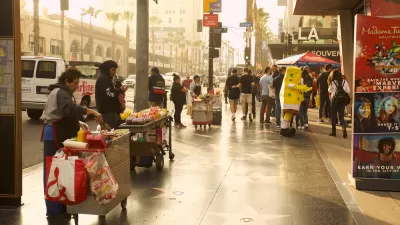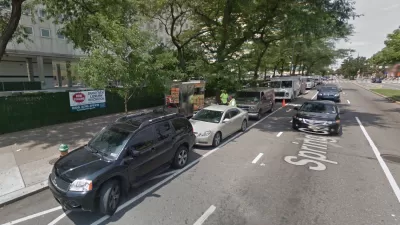Several big stories, all rolled into one, are emerging in Portland. Changes in zoning have paved the way for high-rises that are proposed for the existing location of the city's famous food stalls.

First came the news, via Luke Hammill, that "[i]n between local landmarks like Voodoo Doughnut, Skidmore Fountain and the Portland Saturday Market, the Goodman family hopes to nestle 11 new buildings, $1.5 billion in investment, a grocery store and an untold number of new office workers, shoppers and residents." The Ankeny Blocks development, as its currently called, is proposed "in anticipation of zoning changes the city plans to make that would allow developers to build taller buildings downtown."
All by itself, the development proposal would be one of the Pacific Northwest's biggest planning and urbanism stories, thanks to the new building height, proposed for an already bustling and treasured neighborhood, resulting from a change to the zoning code for the downtown area. Hammill provides more details on the proposed development, as well as insight into the implications and importance of the new development and the land use regulation changes, from Ethan Seltzer, Portland State University professor of urban studies and the former president of the city's planning commission.
Matthew Korfhage picked up on a different story within that story, however, noting that the development plans would displace three of Portland's "most central food cart pods—including its oldest…" A point not discussed in Hammill's article is that some of the surface parking lots targeted for the Ankeny Blocks are currently food cart pods.
According to Korfhage, "Brett Burmeister at Food Carts Portland was the first to take note of the three pods amid the planned developments." Burmeister also issued a call to action for food cart owners and their fans: "Food cart owners need to come together and get in front of City Council and let them know that Portland street food scene is part of the city fabric. Every city has it, so as we develop, we need to find a way to keep it."
FULL STORY: 11 new buildings, $1.5 billion in investment planned for downtown Portland

Alabama: Trump Terminates Settlements for Black Communities Harmed By Raw Sewage
Trump deemed the landmark civil rights agreement “illegal DEI and environmental justice policy.”

Study: Maui’s Plan to Convert Vacation Rentals to Long-Term Housing Could Cause Nearly $1 Billion Economic Loss
The plan would reduce visitor accommodation by 25% resulting in 1,900 jobs lost.

Why Should We Subsidize Public Transportation?
Many public transit agencies face financial stress due to rising costs, declining fare revenue, and declining subsidies. Transit advocates must provide a strong business case for increasing public transit funding.

Paris Bike Boom Leads to Steep Drop in Air Pollution
The French city’s air quality has improved dramatically in the past 20 years, coinciding with a growth in cycling.

Why Housing Costs More to Build in California Than in Texas
Hard costs like labor and materials combined with ‘soft’ costs such as permitting make building in the San Francisco Bay Area almost three times as costly as in Texas cities.

San Diego County Sees a Rise in Urban Coyotes
San Diego County experiences a rise in urban coyotes, as sightings become prevalent throughout its urban neighbourhoods and surrounding areas.
Urban Design for Planners 1: Software Tools
This six-course series explores essential urban design concepts using open source software and equips planners with the tools they need to participate fully in the urban design process.
Planning for Universal Design
Learn the tools for implementing Universal Design in planning regulations.
Smith Gee Studio
Alamo Area Metropolitan Planning Organization
City of Santa Clarita
Institute for Housing and Urban Development Studies (IHS)
City of Grandview
Harvard GSD Executive Education
Toledo-Lucas County Plan Commissions
Salt Lake City
NYU Wagner Graduate School of Public Service





























